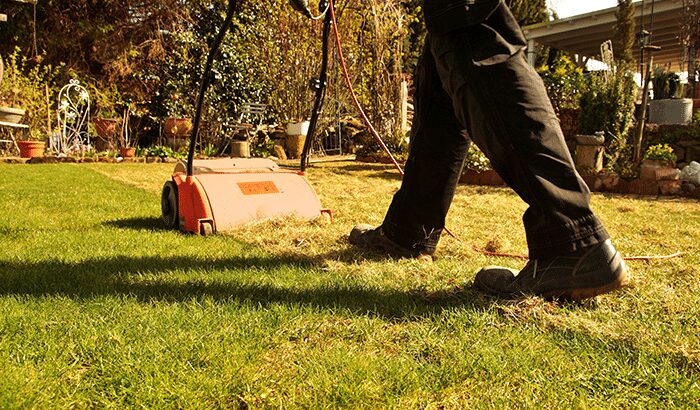If you want to improve your lawn this spring, you’ll need to dedicate some time and effort to the task, but the rewards you’ll reap are worth it!
As temperatures begin to rise and the crocuses and daffodils start to blossom, you know that spring has arrived. These happy signs of springtime also tell you that it’s time to get your lawn prepared for the growing season.
When you start your springtime lawn care greatly depends on the climate in your area. If you live in a snowy region, make sure the snow season has ended before rolling up your sleeves. For homeowners in most places, there are eight tasks you’ll want to complete to enhance your lawn this season.
8 Steps to Improve Your Lawn This Spring
Deeply Rake Your Lawn — Prepare your lawn for new growth by raking your grass. A few remaining leaves may still be on the ground; however, early springtime raking is more geared at removing thatch.
Like your home, your lawn requires spring-cleaning, and by raking thoroughly and deeply with a flexible leaf rake, you can break up any remnants of turfgrass from last year. Removing matted patches of grass will allow new grass to grow in a healthy environment.
Aerate If Needed — Does your lawn experience a lot of heavy traffic? If so, you may need to aerate. Lots of playing or running on your lawn can result in the soil below compacting. When soil is compacted, the required air and water cannot effectively reach the grassroots.
While spring is not the ideal time for lawn aerating, it may be necessary to improve your lawn. If you must aerate this season, try to do it around Memorial Day. You can do the job yourself by investing in your own lawn aerator or renting one at your local big box hardware store. Another option is to hire a professional crew.
Assess Your Soil — If your lawn grows moss, it could signify acidic soil, while yellowing grass could mean extreme alkaline. Grass grows its best in a neutral pH soil. But before adding soil amendments, send a sample of your soil to your local agricultural extension office to learn more about your soil’s acidity. They’ll be able to tell you the best ways to neutralize your soil.
Fill In The Gaps — Between heavy traffic, dog spots, or overall neglect, your lawn could be looking a bit bare or patchy. Thankfully, filling in the gaps is easy when you hire the job out to a trusted and knowledgeable sodding company. Many people believe that sod is only for full yards. However, sod can be a great way to fix a patchy lawn riddled with bare spots.
Fertilize Your Grass — Nourish your lawn with a light feeding of organic fertilizer in the spring. Make sure you don’t use a heavy handle when spreading it around since too much fertilizer can result in weed problems and grass disease.
NOTE: If you fertilize later in the fall, your lawn typically still has plenty to feed on in the spring.
Add Pre-Emergent Herbicides — Lawn enthusiasts know that spring lawn care is just as much about preventing weeds as it is about fostering healthy grass growth. Not all lawn weeds were created the same, which means getting rid of them isn’t a one-size-fits-all fix.
Depending on whether a weed is a perennial or an annual, you will either use a pre-or post-emergent herbicide. Though, to fight off crabgrass, you may need to use both. Pre-emergent herbicides tackle weeds before their seedlings have a chance to emerge. They form a chemical barrier on the top layer of the soil that coats seeds, stopping them from growing shoots and roots.
Note that, if you use pre-emergent herbicides, don’t plan to core aerate until fall since it can decrease the effectiveness of the weed killer. It is also important to note that pre-emergent herbicides will prevent successful overseeding. If you plan to lay down pre-emergent weed killer, you’ll want to wait until early fall to overseed with turfgrass seed.
Pull Spring Weeds or Apply Post-Emergent Herbicides — Despite their cheery, yellow facade, dandelions are stubborn perennial weeds that make their first appearance in the spring. Getting rid of these weeds can be tedious, but it is worth it so they don’t take over. Before they produce seeds, snap off the flowers at their stems.
Or, if you are feeling ambitious, use a shovel to remove them at the root to keep them from sprouting again. If you opt for a post-emergent weed killer for dandelions, choose one that’s formulated for broadleaf weeds. Other late spring weeds you’ll come across include wild riots, white clover, chickweed, and more.
Give Your Lawn Mower Some TLC — Once spring has sprung, it’s time to bring out your lawnmower and make sure it’s in good working order. Start it up to make sure it doesn’t give you a hard time; delayed starts could mean it’s time for a good tune-up.
Ideally, you will give your lawnmower some TLC every year come spring. This includes sharpening your mower blades to ensure they can effectively sever the blades of grass versus tearing, which can lead to brown, ragged tips. If your mower needs more than a tune-up, it could be time to invest in a new one.
Enhance Your Lawn With Monarch Sod
Let the pros at Monarch Sod help improve your lawn this spring. If your yard has dead patches or needs a total overhaul, now is a great time to get the job done. Our trusted and experienced team can help you achieve a lush and beautiful lawn just in time for summer.
We are located in Lehi, Utah, and we’re ready to help the residents and businesses in Salt Lake and Utah Valley with all of your sod needs. Contact us to learn more today!
var /*99586587347*/ toto slot










